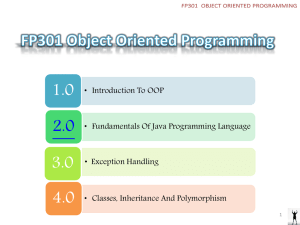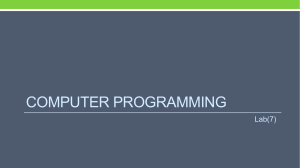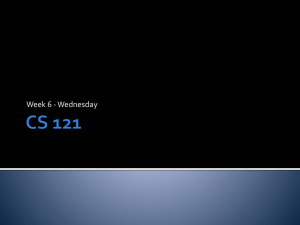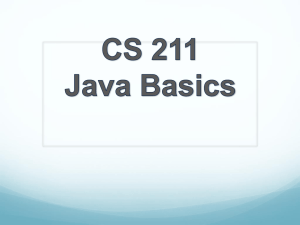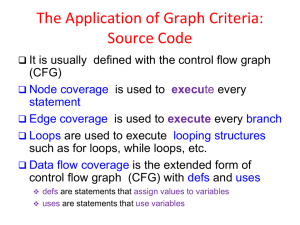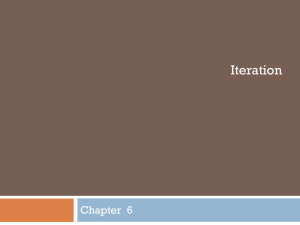System.out.println - Fort Thomas Independent Schools
advertisement
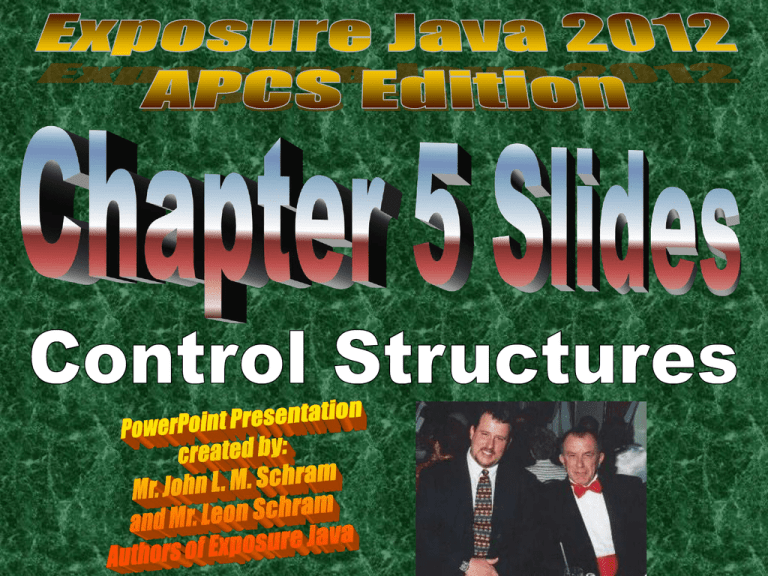
Program Flow
Program Flow follows the exact
sequence of listed program statements,
unless directed otherwise by a Java
control structure.
Types of
Control Structures
•
Simple Sequence
•
Selection also called:
-
•
Decision Making
Conditional Branching
Alternation
Repetition also called:
-
Looping
Iteration
Simple Sequence
Program Statement
Program Statement
Program Statement
Program Statement
One-Way Selection
Program Statement
Condition
True
False
Program Statement
Program Statement
Program Statement
Two-Way Selection
Program Statement
True
Condition
False
Program Statement
Program Statement
Program Statement
Program Statement
Multiple-Way Selection
Selection Variable
Selection Constant
No Match
Selection Constant
No Match
Selection Constant
Match
Match
Match
No Match
Program Statement
Program Statement
Program Statement
Program Statement
Repetition
Program Statement
Program Statement
Program Statement
Condition
True
False
Program Statement
Conditional Statement
Definition
A conditional statement is a
program expression that
evaluates to true or false.
Most conditional statements
require a relational operator.
All conditions must be placed
inside (parentheses).
Relational Operators
Name
Operator Expression Evaluates
Greater than
==
!=
<
>
Less than or
equals
<=
Greater than
or equals
>=
Equals
Not Equals
Less than
5 == 5
5 == 10
50 != 25
100 != 100
100 < 200
200 < 100
200 > 100
200 > 200
100 <= 200
200 <= 200
200 <= 100
100 >= 200
200 >= 200
200 >= 100
true
false
true
false
true
false
true
false
true
true
false
false
true
true
Important Note:
The relational operators shown on the previous
slide will be used in the Java example programs
that demonstrate the different control structures.
Be careful not to confuse the equality operator
( = = ) with the assignment operator ( = ).
Before we demonstrate Control Structures, we
will look at a few examples of Program Input to
make the Control Structures examples more
meaningful.
// Java0501.java
// This program demonstrates user keyboard input during program
// execution.
// Many program features will be used that will be explained later.
import java.util.Scanner;
public class Java0501
{
public static void main (String args[])
{
Scanner input = new Scanner(System.in);
System.out.println("\nJAVA0501.JAVA\n");
System.out.print("Enter name ===>> ");
String name = input.nextLine();
System.out.println("Name Entered:
" + name);
System.out.println();
}
}
// Line 1
// Line 2
// Line 3
// Line 4
// Java0502.java
// This program demonstrates how to use <nextLine> for three separate String
// keyboard inputs.
import java.util.Scanner;
public class Java0502
{
public static void main (String args[])
{
System.out.println("\nJAVA0502.JAVA\n");
Scanner input = new Scanner(System.in);
System.out.print("Enter Line 1 ===>> ");
String input1 = input.nextLine();
System.out.print("Enter Line 2 ===>> ");
String input2 = input.nextLine();
System.out.print("Enter Line 3 ===>> ");
String input3 = input.nextLine();
System.out.println();
System.out.println(input1);
System.out.println(input2);
System.out.println(input3);
System.out.println();
}
}
// Java0503.java
// This program demonstrates <String> objects concatenation with
// keyboard entered data.
import java.util.Scanner;
public class Java0503
{
public static void main (String args[])
{
System.out.println("\nJAVA0503.JAVA\n");
Scanner input = new Scanner(System.in);
System.out.print("Enter 1st Number ===>> ");
String number1 = input.nextLine();
System.out.print("Enter 2nd Number ===>> ");
String number2 = input.nextLine();
String sum = number1 + number2;
System.out.println();
System.out.println(number1 + " + " + number2 + " = " + sum);
System.out.println();
}
}
// Java0504.java
// This program uses the <nextInt> method to enter integers from the keyboard.
// It is now possible to correctly add the two numbers.
import java.util.Scanner;
public class Java0504
{
public static void main (String args[])
{
System.out.println("\nJAVA0504.JAVA\n");
Scanner input = new Scanner(System.in);
System.out.print("Enter 1st Number ===>> ");
int number1 = input.nextInt();
System.out.print("Enter 2nd Number ===>> ");
int number2 = input.nextInt();
int sum = number1 + number2;
System.out.println();
System.out.println(number1 + " + " + number2 + " = " + sum);
System.out.println();
}
}
// Java0505.java
// This program demonstrates how to use <nextDouble> for three separate double
// keyboard inputs, which are used to display the mean.
import java.util.Scanner;
public class Java0505
{
public static void main (String args[])
{
System.out.println("\nJAVA0505.JAVA\n");
Scanner input = new Scanner(System.in);
System.out.print("Enter Number 1 ===>> ");
double n1 = input.nextDouble();
System.out.print("Enter Number 2 ===>> ");
double n2 = input.nextDouble();
System.out.print("Enter Number 3 ===>> ");
double n3 = input.nextDouble();
System.out.println();
System.out.println(n1);
System.out.println(n2);
System.out.println(n3);
double mean = (n1+n2+n3)/3;
System.out.println();
System.out.println("The mean is " + mean);
System.out.println();
}
}
Scanner class Input Methods
nextLine() is used to enter string information.
nextInt() is used to enter integer information.
nextDouble() is used to enter real# information.
// Java0506.java
// This program demonstrates one-way selection with <if>.
// Run the program twice.
// First with Sales equals to 300,000 and a second time with Sales equals 500,000.
import java.util.Scanner;
public class Java0506
{
public static void main (String args[])
{
System.out.println("\nJAVA0506.JAVA\n");
Scanner keyboard = new Scanner(System.in);
System.out.print("Enter Sales ===>> ");
double sales = keyboard.nextDouble();
double bonus = 250.00;
if (sales >= 500000.0)
bonus += 500.0;
System.out.println("Yearly bonus:
" + bonus);
System.out.println();
}
}
// Java0506.java
// This program demonstrates one-way selection with <if>.
// Run the program twice.
// First with Sales equals to 300,000 and a second time with Sales equals 500,000.
import java.util.Scanner;
public class Java0506
{
public static void main (String args[])
{
System.out.println("\nJAVA0506.JAVA\n");
Scanner keyboard = new Scanner(System.in);
System.out.print("Enter Sales ===>> ");
double sales = keyboard.nextDouble();
double bonus = 250.00;
if (sales >= 500000.0)
bonus += 500.0;
System.out.println("Yearly bonus:
" + bonus);
System.out.println();
}
}
Indentation Rule:
Java syntax uses freeform program style.
Program statements may be placed on multiple
lines with or without indentation.
By convention, control structures and their
conditional statements are placed on one line.
The program statement that is executed, if the
condition is true, is placed on the next line, and
indented below the conditional statement.
if(Sales >= 500000)
Bonus += 500;
if(Sales >=500000) Bonus += 500;
Important Note:
Headings are NOT program statements
and therefore do not get a semicolon!
This applies to class headings and
method headings.
It also applies to
control structure
headings!
// Java0507.java
// This program demonstrates one-way selection with <if>.
// It also shows that only one statement is controlled.
// Run the program twice. First with Sales equals to 300,000
// and then a second time with Sales equals to 500,000.
import java.util.Scanner;
public class Java0507
{
public static void main (String args[])
{
System.out.println("\nJAVA0507.JAVA\n");
Scanner keyboard = new Scanner(System.in);
System.out.print("Enter Sales ===>> ");
Double sales = keyboard.nextDouble();
double bonus = 250.00;
if (sales >= 500000.0)
bonus += 500.0;
System.out.println("Your sales >=
500,000.00");
System.out.println("You will receive 500.00 extra bonus.");
System.out.println ("Yearly bonus:
System.out.println();
}
}
" + bonus);
// Java0508.java
// This program demonstrates one-way selection with <if>. It fixes the
// logic problem of the previous program with block structure by using braces.
import java.util.Scanner;
public class Java0508
{
public static void main (String args[])
{
System.out.println("\nJAVA0508.JAVA\n");
Scanner keyboard = new Scanner(System.in);
System.out.print("Enter Sales ===>> ");
double sales = keyboard.nextDouble();
double bonus = 250.00;
if (sales >= 500000.0)
{
bonus += 500.0;
System.out.println("Your sales >=
500,000.00");
System.out.println("You will receive 500.00 extra bonus.");
}
System.out.println("Yearly bonus:
System.out.println();
}
}
" + bonus);
One-Way Selection
General Syntax:
if (condition true)
execute program statement
Specific Examples:
if (counter > 100)
System.out.println("Counter exceeds 100");
if (savings >= 10000)
{
System.out.println("It’s skiing time");
System.out.println("Let’s pack");
System.out.println("Remember your skis");
}
Two-Way Selection
Real Life Example
I35W takes you
to Fort Worth.
I35E takes you
to Dallas.
Interstate 35 splits into I35W and I35E just North of Hillsboro.
// Java0509.java
// This program demonstrates two-way selection with <if..else>.
import java.util.Scanner;
public class Java0509
{
public static void main (String args[])
{
System.out.println("\nJAVA0509.JAVA\n");
Scanner keyboard = new Scanner(System.in);
System.out.print("Enter SAT ===>> ");
int sat = keyboard.nextInt();
if (sat >= 1100)
System.out.println("You are admitted");
else
System.out.println("You are not admitted");
System.out.println();
}
}
// Java0510.java
// This program demonstrates two-way selection with <if..else>.
// Multiple statements require the use of block structure.
import java.util.Scanner
public class Java0510
{
public static void main (String args[])
{
System.out.println("\nJAVA0510.JAVA\n");
Scanner keyboard = new Scanner(System.in);
System.out.print("Enter SAT ===>> ");
int sat = keyboard.nextInt();
if (sat >= 1100)
{
System.out.println("You are admitted");
System.out.println("Orientation will start in June");
}
else
{
System.out.println("You are not admitted");
}
System.out.println("Please try again when your SAT improves.");
System.out.println();
}
}
Two-Way Selection
General Syntax:
if (condition true)
execute first program statement
else // when condition is false
execute second program statement
Specific Example:
if (gpa >= 90.0)
System.out.println ("You’re an honor graduate");
else
System.out.println ("You’re not an honor graduate");
Multi-Way Selection
Real Life Example
// Java0511.java
// This program demonstrates multi-way selection with <switch> and <case>.
// This program compiles, but displays illogical output.
import java.util.Scanner;
public class Java0511
{
public static void main (String args[])
{
System.out.println("\nJAVA0511.JAVA\n");
Scanner keyboard = new Scanner(System.in);
System.out.print("Enter Month Number ===>> ");
int month = keyboard.nextInt();
System.out.println();
switch (month)
{
case 1 : System.out.println("January");
case 2 : System.out.println("February");
case 3 : System.out.println("March");
case 4 : System.out.println("April");
case 5 : System.out.println("May");
case 6 : System.out.println("June");
case 7 : System.out.println("July");
case 8 : System.out.println("August");
case 9 : System.out.println("September");
case 10 : System.out.println("October");
case 11 : System.out.println("November");
case 12 : System.out.println("December");
}
System.out.println();
}
}
// Java0512.java
// This program demonstrates multi-way selection with <switch> and <case>.
// This program adds <break> and <default>. The use of <break> is required for logical output.
import java.util.Scanner;
public class Java0512
{
public static void main (String args[])
{
System.out.println("\nJAVA0512.JAVA\n");
Scanner keyboard = new Scanner(System.in);
System.out.print("Enter Month Number {1-12} ===>> ");
int month = keyboard.nextInt();
System.out.println();
switch (month)
{
case 1 : System.out.println("January");
break;
case 2 : System.out.println("February");
break;
case 3 : System.out.println("March");
break;
case 4 : System.out.println("April");
break;
case 5 : System.out.println("May");
break;
case 6 : System.out.println("June");
break;
case 7 : System.out.println("July");
break;
case 8 : System.out.println("August");
break;
case 9 : System.out.println("September"); break;
case 10 : System.out.println("October");
break;
case 11 : System.out.println("November"); break;
case 12 : System.out.println("December"); break;
default : System.out.println("This is not a valid month number.");
}
System.out.println();
}
}
Java 7.0 Warning
The next 2 program examples use a
String selection variable with switch.
This will only compile and execute if
your JDK (Java Development Kit)
is version 7.0 or newer.
// Java0513.java
// This program demonstrates <switch> used with the <String> data type.
// This requires the uses of the Java 7.0 or later.
// It also shows that multiple program statements can be placed
// between the <case> and <break> commands.
// This is the one time {braces} are NOT used to control multiple statements.
import java.util.Scanner;
public class Java0513
{
public static void main (String args[])
{
System.out.println("\nJAVA0513.JAVA\n");
Scanner input = new Scanner(System.in);
System.out.print("Enter a day abbreviation, like (Sun, Mon, Tue, etc.) ===>> ");
String day = input.nextLine();
System.out.println();
switch (day)
{
case "Sun" :
System.out.println("Sunday");
System.out.println("No School");
break;
case "Mon" :
System.out.println("Monday");
System.out.println("School Day");
break;
case "Tue" :
System.out.println("Tuesday");
System.out.println("School Day");
break;
case "Wed" :
System.out.println("Wednesday");
System.out.println("School Day");
break;
case "Thu" :
System.out.println("Thursday");
System.out.println("School Day");
break;
case "Fri" :
System.out.println("Friday");
System.out.println("School Day");
break;
case "Sat" :
System.out.println("Saturday");
System.out.println("No School");
break;
default : System.out.println("This is not a day of the week.");
}
System.out.println();
}
}
Program Note
In order to focus on the important and
relevant parts of each program, several
programs will not be shown in their
entirety. Rather, a segment of the
program will be shown that focuses on
the key point. You have the complete
programs on your computer.
// Java0514.java
// This <String> example shows a more complex use of the <switch> structure,
// which can handle multiple matches for the same output.
System.out.print("Enter the first name of someone in Leon Schram's family. ===>> ");
String firstName = input.nextLine();
switch (firstName)
{
case "Isolde" :
System.out.println("This is Mr. Schram's wife.");
break;
case "John" :
case "Greg" :
System.out.println("This is one of Mr. Schram's sons.");
break;
case "Maria" :
case "Heidi" :
System.out.println("This is one of Mr. Schram's daughters.");
break;
case "Mike" :
case "David" :
System.out.println("This is one of Mr. Schram's sons-in-law.");
break;
case "Diana" :
System.out.println("This is Mr. Schram's daughter-in-law.");
break;
case "Jessica" :
case "Haley" :
case "Brenda" :
case "Mari" :
System.out.println("This is one of Mr. Schram's granddaughters.");
break;
case "Anthony" :
case "Alec" :
case "Maddox" :
case "Jaxon" :
case "Braxton" :
System.out.println("This is one of Mr. Schram's grandsons.");
break;
case "Austrid" :
case "Ingrid" :
System.out.println("This is one of Mr. Schram's sisters.");
break;
case "Remy" :
System.out.println("This is Mr. Schram's brother.");
break;
case "Darlene" :
case "Kassi" :
case "Holli" :
System.out.println("This is one of Mr. Schram's nieces.");
break;
case "Gene" :
case "Sean" :
case "Blake" :
System.out.println("This is one of Mr. Schram's nephews.");
break;
default :
System.out.println("This is not someone in Mr. Schram's immediate family.");
System.out.println("Make sure you spell the name correctly and only capitalize the first letter.");
}
Multiple-Way Selection
General Syntax
switch(selectionVariable)
{
case selectionConstant:
program statement;
program statement;
:
:
:
break;
case selectionConstant:
program statement;
program statement;
:
:
:
break;
default
program statement;
program statement;
:
:
:
}
Multiple-Way Selection
Specific Example
switch(courseGrade)
{
case 'A' : points = 4; break;
case 'B' : points = 3; break;
case 'C' : points = 2; break;
case 'D' : points = 1; break;
case 'F' : points = 0; break;
default : System.out.println("Error");
}
The default statement is used to handle the situation when a
proper match is not found. Frequently an error message is
used to indicate that no match was found.
// Java0515.java
// This program displays 40 identical lines very inefficiently
// with 40 separate println statements.
public class Java0515
{
public static void main(String args[])
{
System.out.println("\nJAVA0515.JAVA\n");
System.out.println("Eat at Joe's friendly diner for the best lunch value");
System.out.println("Eat at Joe's friendly diner for the best lunch value");
System.out.println("Eat at Joe's friendly diner for the best lunch value");
System.out.println("Eat at Joe's friendly diner for the best lunch value");
System.out.println("Eat at Joe's friendly diner for the best lunch value");
System.out.println("Eat at Joe's friendly diner for the best lunch value");
System.out.println("Eat at Joe's friendly diner for the best lunch value");
System.out.println("Eat at Joe's friendly diner for the best lunch value");
System.out.println("Eat at Joe's friendly diner for the best lunch value");
System.out.println("Eat at Joe's friendly diner for the best lunch value");
System.out.println("Eat at Joe's friendly diner for the best lunch value");
System.out.println("Eat at Joe's friendly diner for the best lunch value");
System.out.println("Eat at Joe's friendly diner for the best lunch value");
System.out.println("Eat at Joe's friendly diner for the best lunch value");
System.out.println("Eat at Joe's friendly diner for the best lunch value");
:
:
:
:
:
:
:
:
:
:
:
:
:
:
:
:
// Java0516.java
// This program displays 40 identical lines efficiently
// with one println statement and a loop structure.
public class Java0516
{
public static void main(String args[])
{
System.out.println("\nJAVA0516.JAVA\n");
int k;
for (k = 1; k <= 40; k++)
System.out.println("Eat at Joe's friendly diner for the best lunch value");
}
}
// Java0516.java
// This program displays 40 identical lines efficiently
// with one println statement and a loop structure.
public class Java0516
{
public static void main(String args[])
{
System.out.println("\nJAVA0516.JAVA\n");
int k;
for (k = 1; k <= 40; k++)
System.out.println("Eat at Joe's friendly diner for the best lunch value");
}
} Part 1 is used to
initialize the counter
(Loop Control
Variable).
// Java0516.java
// This program displays 40 identical lines efficiently
// with one println statement and a loop structure.
public class Java0516
{
public static void main(String args[])
{
System.out.println("\nJAVA0516.JAVA\n");
int k;
for (k = 1; k <= 40; k++)
System.out.println("Eat at Joe's friendly diner for the best lunch value");
}
} Part 1 is used to
initialize the counter
(Loop Control
Variable).
Part 2 is a condition.
As long as it is true
the loop will keep
repeating.
// Java0516.java
// This program displays 40 identical lines efficiently
// with one println statement and a loop structure.
public class Java0516
{
public static void main(String args[])
{
System.out.println("\nJAVA0516.JAVA\n");
int k;
for (k = 1; k <= 40; k++)
System.out.println("Eat at Joe's friendly diner for the best lunch value");
}
} Part 1 is used to
initialize the counter
(Loop Control
Variable).
Part 2 is a condition.
As long as it is true
the loop will keep
repeating.
Part 3 indicates
what the counter
counts by. ++
means count by 1.
// Java0517.java
// This program displays consecutive numbers 1 through 15.
// It also shows how the loop control variable may be
// defined inside the <for> program statement.
public class Java0517
{
public static void main(String args[])
{
System.out.println("\nJAVA0517.JAVA\n");
for (int k = 1; k <= 15; k++)
System.out.print(k + " ");
System.out.println();
}
}
Defining the Loop Control Variable
Before the loop heading (not used much)
int k;
for (k = 1; k <= 10; k++)
{
System.out.println("Hello World");
}
Inside the loop heading (preferred approach)
for (int k = 1; k <= 10; k++)
{
System.out.println("Hello World");
}
// Java0518.java
// This program demonstrates how to use block structure
// with a <for> loop control structure.
public class Java0518
{
public static void main(String args[])
{
System.out.println("\nJAVA0518.JAVA\n");
for (int k = 1; k <= 5; k++)
{
System.out.println("####################################");
System.out.println("Line Number " + k);
}
System.out.println();
}
}
// Java0519.java
// This program displays various counting schemes.
// It also demonstrates the versatility of the <for> loop.
public class Java0519
{
public static void main(String args[])
{
System.out.println("\nJAVA0519.JAVA\n");
for (int p = 1; p <= 15; p++)
System.out.print(p + " ");
You do NOT always have to use
System.out.println("\n");
++ in the 3rd part of a for loop.
for (int q = 1; q <= 15; q+=3)
System.out.print(q + " ");
You can count by any amount.
System.out.println("\n");
for (int r = 15; r >= 1; r--)
System.out.print(r + " ");
You can count backwards.
System.out.println("\n");
for (double s = 0; s <= 3; s+=0.5)
System.out.print(s + " ");
You can count by fractional
System.out.println("\n");
amounts.
for (char t = 'A'; t <= 'Z'; t++)
System.out.print(t + " ");
You can even count with
System.out.println("\n\n");
}
characters.
}
Fixed Repetition
Java has a variety of control structures for repetition.
Other computer science terms for repetition are looping and iteration.
Fixed Repetition is done with the for loop structure.
General Syntax:
for (Part1; Part2; Part3)
loop body;
The for loop has three distinct parts:
Part1 initializes the Loop Control Variable.
Part2 sets the exit condition for the loop.
Part3 determines how the LCV changes.
Specific Example:
for (k = 1; k <= 10; k++)
System.out.println("Java is 10 times more fun");
Conditional Repetition
Real Life Examples
Note to Students with
Advanced Knowledge
It is possible to treat the for loop structure like a
conditional loop that is not fixed. In fact, a for loop can be
designed to behave exactly like a while loop.
It is my intention to use and treat a for loop like a fixed
iteration loop and use the while loop and do...while loop
for other repetition situations.
This approach is less likely to cause confusion. At some
later date, when you are comfortable with all the control
structures, you can use them in any appropriate manner.
If this does not make sense to you, do not worry.
Ignore this little summary box, and move on.
// Java0520.java
// This program demonstrates the precondition <while> loop.
// This loop will continue until the winning number is entered.
// This loop does not repeat in a fixed number of times.
import java.util.Scanner;
public class Java0520
{
public static void main(String args[])
{
System.out.println("\nJAVA0520.JAVA\n");
Scanner input = new Scanner(System.in);
System.out.println("Guess the number between 1 and 100");
System.out.println("The first person to guess the number wins the price.");
System.out.println();
int guess = 0;
while (guess != 31)
{
System.out.print("Enter your guess ==>> ");
guess = input.nextInt();
if (guess == 31)
System.out.println("You are the winner.");
else
System.out.println("That is not the winning number.");
System.out.println();
}
}
}
Pre-Conditional Repetition
General Syntax:
initialize condition variable before the while loop
while(condition is true)
{
loop body
alter condition variable in the loop body
}
Specific Example:
int pin = 0;
// initialize condition variable
while(pin != 5678)
{
System.out.print("Enter pin. ===>> ");
pin = input.nextInt(); // alter condition variable
}
System.out.println("Welcome.");
Program Segment
NoNo #1
Program Segment
YesYes #1
int x = 0;
while(x < 10)
System.out.println(x);
int x = 0;
while(x < 10)
{
x++;
System.out.println(x);
}
The loop condition variable,
x, never changes. The loop
will not exit.
The loop condition variable,
x, changes. The loop exits
when x reaches 10.
Program Segment
NoNo #2
Program Segment
YesYes #2
int x;
while(x < 10)
{
x++;
System.out.println(x);
}
int x = 0;
while(x < 10)
{
x++;
System.out.println(x);
}
The loop condition
variable, x, is never
initialized. This program
will not compile in Java.
The loop condition
variable, x, is initialized.
The program will compile
and execute normally.
// Java0521.java
// This program demonstrates the postcondition <do..while> loop.
// This loop structure guarantees at least one repetition of the loop body.
// Like the <while> loop this is not a "fixed iteration" loop.
import java.util.Scanner;
public class Java0521
{
public static void main(String args[])
{
System.out.println("\nJAVA0521.JAVA\n");
Scanner input = new Scanner(System.in);
System.out.println("Please enter your ATM Person al Identification Number (PIN)!");
System.out.println("\n\n");
int PIN = 0;
do
{
System.out.print("Enter your PIN ==>> ");
PIN = input.nextInt();
System.out.println();
if (PIN == 1234)
System.out.println("Your PIN is correct; you may proceed.");
else
System.out.println("That is not the correct PIN.");
System.out.println("\n\n");
}
while (PIN != 1234);
}
}
Post-Conditional Repetition
General Syntax:
initialize condition variable before the do..while loop
do
{
loop body
alter condition variable in the loop body
}
while(condition is true)
Specific Example:
int pin = 0;
// initialize condition variable
do
{
System.out.print("Enter pin. ===>> ");
pin = input.nextInt(); // alter condition variable
}
while(pin != 5678); // Not a heading, Semicolon is required.
System.out.println("Welcome.");
Fixed Repetition vs.
Conditional Repetition
Fixed Repetition describes a situation where you know – ahead
of time – how many times you want the loop to repeat.
An example would be drawing exactly 100 circles on the screen.
The command for fixed repetition is for.
Conditional Repetition describes a situation where you do NOT
know how many times the loop will repeat.
The loop has to repeat until some condition is met.
An example would be entering a password.
The command for pre-conditional repetition is while.
The commands for post-conditional repetition is do..while.
AP Exam Alert
Selection Control Structures
The one-way selection if is tested on the AP Exam.
if (sales >= 500000)
bonus = bonus + 5000.0;
The two-way selection if..else is tested on the AP Exam.
if (sat >= 1200)
System.out.println("You're admitted");
else
System.out.println("You're not admitted");
The multi-way selection switch..case..break is NOT tested on the AP Exam.
switch (grade)
{
case 'A' : gpaPoints = 4; break;
case 'B' : gpaPoints = 3; break;
case 'C' : gpaPoints = 2; break;
case 'D' : gpaPoints = 1; break;
case 'F' : gpaPoints = 0;
}
AP Exam Alert
Repetition Control Structures
The fixed-repetition for loop is tested on the AP Exam.
for (int k = 1; k <= max; k++)
sum += k;
The pre-condition while loop is tested on the AP Exam.
while (k < max)
{
sum += k; k++;
}
The post-condition do..while loop is NOT tested on the AP Exam.
do
{
sum += k;
k++;
}
while (k < max);
// Java0520.java
// This program shows how a control structure can be used with graphics.
// This program draws vertical lines, because x1 & x2 have the same value.
import java.awt.*;
import java.applet.*;
public class Java0520 extends Applet
{
public void paint(Graphics g)
{
int y1 = 100;
int y2 = 500;
for (int x = 50; x < 700; x +=10)
g.drawLine(x,y1,x,y2);
}
}
// Java0523.java
// This program shows how a control structure can be used with graphics.
// This program draws horizontal lines, because y1 and y2 have the same
// value.
import java.awt.*;
import java.applet.*;
public class Java0523 extends Applet
{
public void paint(Graphics g)
{
int x1 = 100;
int x2 = 700;
for (int y = 50; y < 500; y +=10)
g.drawLine(x1,y,x2,y);
}
}
// Java0524.java
// This program shows how a control structure can be used with graphics.
// This program draws diagonal lines, because x1, y1, y2, y2, all four change.
import java.awt.*;
import java.applet.*;
public class Java0524 extends Applet
{
public void paint(Graphics g)
{
int x1 = 50;
int x2 = 200;
int y1 = 50;
int y2 = 300;
for (int k = 1; k < 50; k++)
{
g.drawLine(x1,y1,x2,y2);
x1 += 10;
x2 += 10;
y1 += 5;
y2 += 5;
}
}
// Java0525.java
// This program demonstrates how to rotate a line around a point.
// In this case the (x1,y1) coordinate stays fixed and the (x2,y2) point changes.
import java.awt.*;
import java.applet.*;
public class Java0525 extends Applet
{
public void paint(Graphics g)
{
int x1 = 50;
int y1 = 50;
int x2 = 600;
int y2 = 50;
for (int k = 1; k < 50; k++)
{
g.drawLine(x1,y1,x2,y2);;
y2 += 10;
}
}
}
// Java0526.java
// This program is example of displaying multiple graphics rectangles
// using a loop control structure.
// Note how all rectangle share the same top-left corner.
import java.awt.*;
import java.applet.*;
public class Java0526 extends Applet
{
public void paint(Graphics g)
{
int x = 375;
int y = 275;
int side = 50;
for (int k = 1; k <= 25; k++)
{
g.drawRect(50,50,side,side);
side += 20;
}
}
}
// Java0527.java
// This program is another example of displaying multiple graphics rectangles
// using a loop control structure.
import java.awt.*;
import java.applet.*;
public class Java0527 extends Applet
{
public void paint(Graphics g)
{
int x = 375;
int y = 275;
int side = 50;
for (int k = 1; k <= 25; k++)
{
g.drawRect(x,y,side,side);
x -= 10;
y -= 10;
side += 20;
}
}
}
// Java0528.java
// This program demonstrates how to draw multiple lines easily with
// a loop structure inside a rectangle to form a pattern.
import java.awt.*;
import java.applet.*;
public class Java0528 extends Applet
{
public void paint(Graphics g)
{
g.drawRect(50,50,500,500);
for (int x = 50; x <= 550; x += 10)
g.drawLine(x,50,600-x,550);
}
}
// Java0529.java
// This program continues the pattern started in Java0528.java to
// create an interesting pattern.
import java.awt.*;
import java.applet.*;
public class Java0529 extends Applet
{
public void paint(Graphics g)
{
g.drawRect(50,50,500,500);
for (int x = 50; x <= 550; x += 10)
g.drawLine(x,50,600-x,550);
for (int y = 50; y <= 550; y += 10)
g.drawLine(50,y,550,600-y);
}
}
Lab Experiment 0530
Step 01A
1.
2.
3.
4.
Start JCreator.
Click File, New and Project.
Click Empty Project and Next.
Click the Location Browse button
and navigate to folder Java0530.
5. Click OK.
6. Click Finish twice.
(This is not the same as a double click)
7. Compile (Build) the project.
8. Execute (Run) the project.
Lab Experiment 0530
Step 01B
Program Java0530.java is shown below and you see the
statement Location(8,1), which places the new object at
that location. The other statements you see used here will
be explained in future chapters.
Lab Experiment 0530
Step 02A, 02B & 03
1. Click on the Bug object.
(You will see all the available Bug methods)
2. Click the move method.
3. Click on the Bug object then move
again.
1. Click on the Bug object.
2. Click the turn method.
(The bug turns 45 degrees)
On your own create a small
(3 X 3) square.
Lab Experiment 0531
Step 01 & 02
Create Project Java0531
Execute Project Java0531
The bug creates a pattern of flowers
in the design of an hourglass.
Lab Experiment 0531 – Step 3
ActorWorld world = new ActorWorld();
Bug barry = new Bug();
world.add(new Location(8,1), barry);
world.show();
barry.turn(); barry.turn();
for (int k = 1; k <= 7; k++)
barry.move();
for (int k = 1; k <= 5; k++)
barry.turn();
for (int k = 1; k <= 7; k++)
barry.move();
for (int k = 1; k <= 3; k++)
barry.turn();
for (int k = 1; k <= 7; k++)
barry.move();
for (int k = 1; k <= 3; k++)
barry.turn();
for (int k = 1; k <= 7; k++)
barry.move();
Study this program code.
Lab Experiment 0532
Step 01 & 02
Create Project Java0532
Execute Project Java0532
The bug creates a pattern of flowers
in the design of a spiral.
Lab Experiment 0532 – Step 3
ActorWorld world = new ActorWorld();
Bug barry = new Bug();
world.add(new Location(5,4),barry);
world.show();
for (int k = 1; k <= 2; k++)
barry.move();
barry.turn(); barry.turn();
for (int k = 1; k <= 3; k++)
barry.move();
barry.turn(); barry.turn();
for (int k = 1; k <= 4; k++)
barry.move();
barry.turn(); barry.turn();
for (int k = 1; k <= 5; k++)
barry.move();
barry.turn(); barry.turn();
for (int k = 1; k <= 6; k++)
barry.move();
barry.turn(); barry.turn();
for (int k = 1; k <= 7; k++)
barry.move();
barry.turn(); barry.turn();
for (int k = 1; k <= 8; k++)
barry.move();
barry.turn(); barry.turn();
for (int k = 1; k <= 9; k++)
barry.move();
barry.turn(); barry.turn();
Study this program code.
Lab Experiment 0532
CHALLENGE
The spiral does use loop
structures for efficiency, but
there are really too many
loop structures.
With a combination of loop
structures and decision
structures, the program code
can be much shorter and
create the same exact spiral.
Take some time now and try
to alter the program code.


